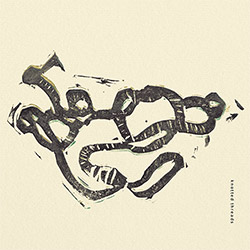
Confirmation of how infrequent musical meetings can be as engaging as those with expected partners, are these five improvisations by Montréal alto saxophonist Yves Charuest and London-based violist Benedict Taylor. The two briefly collaborated a couple of years previously in Taylor's home town and decided to record when the fiddler visited Québec.
Easily enough they swiftly work out a strategy that is both complementary and challenging. Charuest's strained aviary whistles and peeps concentrated with tongue slaps and upwards flattement evolve in counterpoint to Taylor's downwards moving weighty stops and sul tasto glissandi. If stretched reed bleats or squeakier spiccato string runs threaten to pitch the duet from dissonance to atonality, a course reversal re-establishes double counterpoint.
While irregular multiphonics and split-second adjustments from high to low pitches or lyrical to fragmented expositions vibrate throughout the session, the most extensive elaboration is in the introductory "Ossel Hitch" and subsequent "Round Lashing". As the first sets up parameters it also highlights string stropping and sawing double or triple stopping which adds vitality to the saxophonist's parched within-the-horn squawks and dissected scoops. Eventually Taylor's pizzicato strums concentrate reed peeps to concordance.
More of the same, "Round Lashing" adheres together both players' dissonant tones as multiple string strategies and reed extensions become wider. even as elevated timbres are torqued. With the exposition involving both equally, despite continued reed whistles or tongue slaps on one side and thinner buzzsaw-like string spawls on the other, vibrating expressiveness is attained.
Background or geography should never stand in the way of connecting textures in an adept and efficient free music program. The profound association expressed during Knotted Threads' five improvisations provide confirmation of this truism.
Comments and Feedback:



More Recent Reviews, Articles, and Interviews @ The Squid's Ear...


| 
